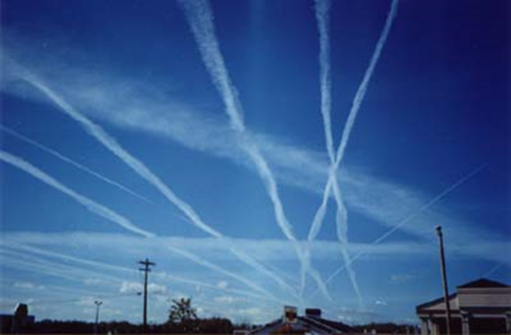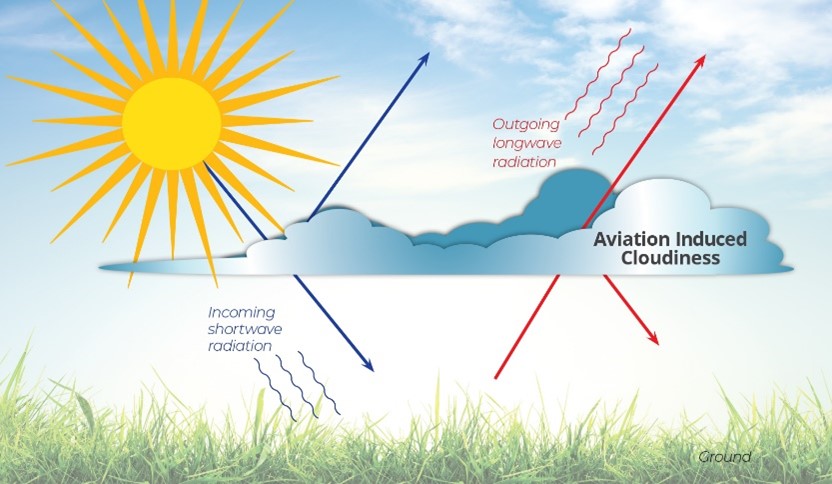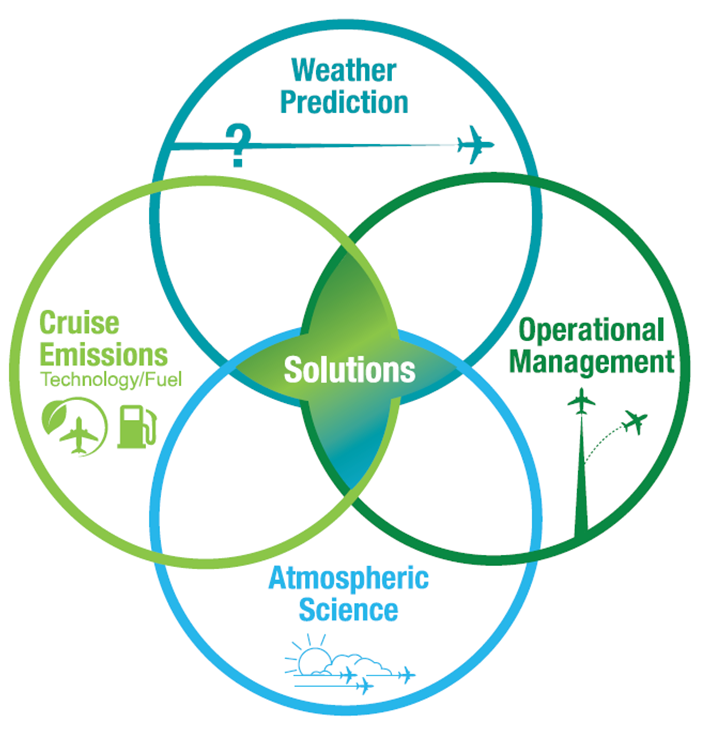
The Federal Aviation Administration (FAA), National Aeronautics and Space Administration (NASA), Department of Energy (DoE), and National Oceanic and Atmospheric Administration (NOAA) are working to improve scientific understanding of contrails and mitigate their impacts. The aviation sector recognizes that these impacts must be addressed in order to achieve a sustainable aviation future which requires collaboration between government agencies and the U.S. Aviation industry.
What are contrails?
Condensation trails (contrails) are ice clouds formed from the condensation of aircraft engine exhaust water vapor onto both co-emitted and naturally occurring particles at cruise altitudes.

Some linear contrails develop into longer-lasting, persistent contrails and diffuse contrail cirrus clouds, which together comprise Aviation Induced Cloudiness (AIC), as depicted in the image below. Contrail cirrus formation and persistence depend on the aircraft engine exhaust composition, which is impacted by engine technology and fuel chemistry, as well as local atmospheric conditions (for example, temperature and relative humidity). Contrails are more likely to form and persist when the ambient air is cold and humid.
Resources for more information:
What are the impacts of contrails?
Persistent contrail cirrus clouds have a measurable effect on the Earth’s energy balance. The figure below shows how contrails reflect incoming sunlight back to space and trap outgoing heat radiation within the atmosphere. The balance between these effects can vary for individual contrails depending on the time of day, as well as other surface and atmospheric properties. Some contrails cool the Earth, while others warm the Earth. Overall, current global models tell us that the global net effect of contrail cirrus clouds today is a warming tendency of a similar magnitude to that from the cumulative emissions of aviation carbon dioxide. The precise amount of net warming tendency from contrail cirrus is uncertain – it could be slightly smaller or significantly greater than that of carbon dioxide. The uncertainty bounds on the net radiative impact of contrail cirrus clouds from today’s models do not indicate that the impact could be zero or cooling.

Why is research needed?
Research is needed to understand and reduce the uncertainty of the radiative impacts of persistent contrail cirrus clouds and provide a data driven approach to inform decision-making. Scientists can confidently say that the net global impact of contrail cirrus clouds today is warming and significant relative to the warming from aviation carbon emissions. However, quantifying the net impact of individual contrails (that can be either warming or cooling) is much more uncertain. More research would improve confidence contrail prediction at regional-to-continental scales. This is necessary to inform potential efforts to avoid or mitigate persistent contrail formation. In addition, there is a continuing need to incorporate new global model simulations and observational estimates into assessments of the net global warming potential from contrail cirrus clouds. Advanced aircraft engine technologies, sustainable aviation fuels, and operational re-routing promise to be important tools for contrail cirrus mitigation. But more research would provide the best ways to improve, advance, and strategically deploy these capabilities across the aviation section in the near-, mid-, and long-term. (Lee et al., 2021 and 2023).
Why is action needed?
Improved understanding of contrails and their impacts is essential for the U.S. to:
- make informed decisions that will ensure U.S. economic competitiveness in the aerospace sector,
- maintain the safety and efficiency of the airspace system,
- remain a global leader by offering state of the art products and technologies that reduce the impacts of civil aviation, and
- support efforts to reduce fuel burn and costs to the flying public.
U.S. Government Contrails Research
United States Government agencies are advancing a contrails research approach and roadmap. The purpose of the contrails research roadmap is to advance the understanding of persistent contrails and their climate impacts to inform future decision making. The roadmap identifies high level goals and defines what is needed to meet these goals. Collaboration between government agencies and the U.S. Aviation industry will be critical to meeting these goals. It will also be critical to continue our collaboration with stakeholders around the world to ensure resources are deployed effectively and research efforts are complementary and coordinated.

The contrails research roadmap is divided into the following four categories to understand various aspects of how contrails form, persist, impact the environment and how their impacts could be mitigated.
- Atmospheric Science: Process-level scientific understanding of how aviation emissions evolve and interact with Earth’s atmosphere and radiation budget across local, regional, and global spatial scales and over daily, annual, and centennial timescales.
- Weather Prediction: Ability to forecast/nowcast ice supersaturated regions of the atmosphere, persistent contrail formation, and contrail cirrus radiative impact over hours to days.
- Cruise Emissions: Fundamental understanding of how advanced engine technologies, sustainable aviation fuel (SAF), and other alternative fuels (e.g., hydrogen) impact aircraft emissions and contrails.
- Operational Management: Ability to make effective and efficient operational decisions impacting contrails and the national airspace that balance economics, sustainability, and societal needs all without compromising safety.

Additional Resources
- FAA
- ASCENT – The Aviation Sustainability Center
- NASA
- Sustainable Flight National Partnership
- Advanced Air Vehicles Program
- Transformative Aeronautics Concepts Program
- Airspace Operations and Safety Program
- GE Aerospace, NASA collaborate on contrail impact flight tests
- Boeing Eco Demonstrator – SAF Emission Testing partnership with NASA and FAA
- NOAA
- European Union Aviation Safety Agency (EASA)
- Airlines and Manufacturers
